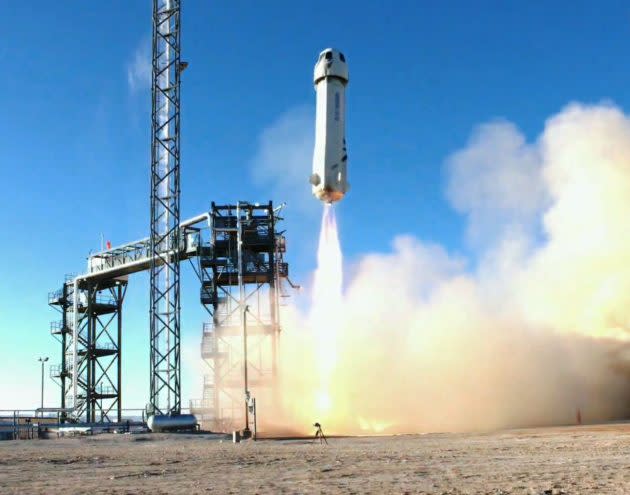Blue Origin sends NASA-backed payloads to space and back on suborbital rocket ship

Amazon billionaire Jeff Bezos’ Blue Origin space venture sent eight NASA-sponsored scientific payloads to the edge of space and back on its New Shepard suborbital spaceship, marking another step toward putting people on board.
The rocket lifted off into clear, chilly skies from Blue Origin’s launch site in West Texas at 9:08 a.m. CT (7:08 a.m. PT). Minutes after launch, New Shepard’s gumdrop-shaped capsule separated from the hydrogen-fueled booster and headed to a maximum unofficial altitude of 350,775 feet (66 miles or 107 kilometers). That’s well above the 100-kilometer Karman Line that currently serves as the internationally accepted boundary of space.
The reusable booster maneuvered itself back to a landing on a pad not far from where it was launched, while the capsule deployed its parachutes and drifted back down to the desert terrain.
“Welcome home, New Shepard. Wow!” launch commentator Ariane Cornell, Blue Origin’s head of astronaut strategy and sales, said during today’s webcast.
In a follow-up tweet, Blue Origin said the 10-minute, 15-second mission “looks to have been a wholly successful flight.”
“A perfect day,” Bezos said in an Instagram posting:
A post shared by Jeff Bezos (@jeffbezos) on Jan 23, 2019 at 11:06am PST
It was the 10th test flight for the New Shepard program, and the fourth go-round for the same booster-and-capsule pair. Blue Origin had initially planned for launch on Dec. 18, but it took more than a month to work through a ground infrastructure issue and other technical snags — and wait for acceptable weather.
The scientific payloads packed aboard the capsule were flown under the auspices of NASA’s Flight Opportunities Program, and included experiments aimed at characterizing the vibrations of flight and the spacecraft environment during the few minutes of weightlessness at the top of the ride.
“These NASA-supported experiments will help advance in-space propulsion technologies, habitation systems, science instruments and other capabilities crucial for exploration,” NASA Administrator Jim Bridenstine said in a recorded video. “Like the researchers, I’m excited to learn the results from this very important flight.”
New Shepard is designed to fly itself autonomously, and there were no people aboard the craft for today’s test flight. But Cornell said passengers could soon step aboard the next New Shepard spaceship, which has already been built.
“We’re aiming for the end of this year, by the end of this year. But as we’ve said before, we are not in a rush,” Cornell said. “We want to take our time. We want to do this right.”
The company hasn’t yet announced the ticket price, and it’s not yet taking reservations (although would-be fliers can sign up for updates).
Bezos, the world’s richest person, has said he’s selling roughly a billion dollars’ worth of Amazon stock every year to support Blue Origin. That sum covers the New Shepard suborbital space program as well as the New Glenn orbital rocket development program and advanced projects such as the Blue Moon lunar lander. (For what it’s worth, Bezos’ current net worth is estimated at $136 billion.)
New Shepard spacecraft and their BE-3 rocket engines are built at the company’s headquarters in Kent, Wash., and then shipped down to West Texas for testing.
For now, the more powerful BE-4 rocket engines for the New Glenn rocket go through the same production pipeline. But Blue Origin is getting ready to build BE-4 engines in Alabama and assemble New Glenn rockets in Florida.
Blue Origin has also been tapped to build BE-4 engines for United Launch Alliance’s next-generation, semi-reusable Vulcan rocket. A groundbreaking ceremony for Blue Origin’s rocket factory in Huntsville, Ala., is scheduled on Friday.
The first New Glenn launch is currently set for 2021 from Launch Complex 36 at Cape Canaveral Air Force Station in Florida.
Bezos’ ultimate goal is to help get humanity established in off-Earth settlements where there’d be plenty of room for the species to spread out.
“We’d have a trillion humans in the solar system, and then we’d have a thousand Mozarts and a thousand Einsteins,” he said last Friday during an awards ceremony in Beverly Hills, Calif. “That’s the world I want my grandchildren’s grandchildren to live in.”
This report has been updated several times since first publication at 7:28 a.m. PT Jan. 23.
More from GeekWire:
Jeff Bezos’ Blue Origin venture sends its New Shepard spaceship to new heights
Jeff Bezos’ Blue Origin venture will send science to space on 10th suborbital flight
Jeff Bezos says Blue Origin gives test dummy ‘a great ride’ on New Shepard suborbital spaceship
After delays, Blue Origin says ‘we are go’ for New Shepard suborbital test flight
